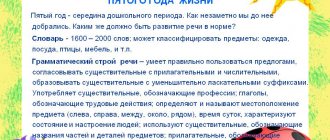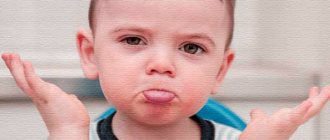In the first few years of a child’s life, the part of the brain responsible for speech development occurs. Failures that occur at this stage must be corrected. Parents often do not pay attention to the fact that the child changes syllables. However, in some cases this may indicate the presence of a deviation, so it is better to consult a specialist. If he discovers a pathology, then only a speech therapist can help get rid of it. But don’t worry too much if your baby gets confused about the syllables. In some cases, this is an age-related phenomenon.
With normal development, three-year-old children begin to reproduce verbal structures according to the laws of euphony. At the age of 1.5 to 2 years, rearrangement of syllables is allowed. For example, instead of the word “plane,” a child may say “baby.” But if such violations do not disappear by 4-5 years, then this indicates the presence of a violation of the syllabic structure of the word. Such problems do not go away on their own, so the help of a speech therapist is necessary.
Types of syllabic disorders
Violation of the syllabic structure of a word is a type of GSD (general speech underdevelopment). OHP occurs in children with minimal brain dysfunction, neurological and psychopathic syndromes and organic lesions of the speech parts of the brain, as well as due to pedagogical neglect. When the syllable structure is violated, experts identify several types of deviations:
- elision. The child shortens words and skips syllables (“bicycle” - “siped”, “TV” - “tizoy”, etc.);
- iterations. The baby increases the number of syllables by adding vowels to them (“room” - “room”, “pumpkin” - “pumpkin”, etc.);
- perseveration. The baby gets stuck on a syllable and repeats it several times (“suitcase” - “che-ma-ma-dan”, “kitty” - “ko-shech-shech-ka”, etc.);
- anticipation. The child changes the next syllable to the previous one or selects a similar one, swaps sounds (“dog” - “babaka”, “frog” - “gugushka”, “hammer” - “tamalok”, etc.);
- contamination. The kid mixes words with each other, swaps the sequence of sounds (“the doctor is treating” - “docchit”, “on the table in the hospital” - “on the table”).
Remember that the development of correct syllable structure is a necessary stage in the formation of a child’s speech, influencing subsequent writing and reading skills.
Techniques
Mastering merging syllables can be achieved in different ways. The first one that comes to mind is to sequentially learn letters, then syllables, and only then start reading words. This method is simple for the teacher, but difficult for the child. The fact is that the 33 letters of the Russian alphabet form close to 200 variant pairs.
Table:
The child will have to cram them, for a long time, and without understanding why it is needed. Of course, this will kill the desire to learn in the bud.
The most convenient and easiest way to master merging syllables is to learn them gradually and together with letters, according to the principle - from the most common and easy to pronounce to the most complex. That is, according to the ABC book.
It is recommended to start studying with the letter “N” (after becoming familiar with vowels). Namely, master its writing, learn to recognize by ear the different parts of a word, determine the soft and hard form. At the next stage, you need to substitute cards with vowels and name the syllables “NA”, “NI”, “WELL”, “NO”. Only after this the child will be able to compose and read the word (“NO-S”, “O-NA”, “NI-Z”, “NI-NA”), using various reading schemes.
As new letters are introduced, new groups of merging syllables will appear. They should be studied separately and in combination with those already studied.
Print out a table with merging syllables and place it on your child’s desk. Gradually he will get used to it and begin to navigate well, find and read the right pair. This is a very useful skill that will make studying easier now and in the future.
Norms for the formation of the syllable structure of a word at different ages
- Children from 0 to 3 years old. Repeating simple syllables “ma-ma”, “ba-ba”, etc.;
- Children from 3 to 4 years old. Reproduction of words of one, two and three syllables (“mint”, “house”, “car”);
- Children from 4 to 5 years old. Reproduction of words with open syllables without a cluster of consonants (“valley”, “mitten”), words of four to five syllables and with a cluster of consonants (“tail”, “bridge”, “builder”, “crumb”, “reed” );
- Children from 5 years old. Repeating sentences with complex words (of 3-4 syllables with a combination of consonants) after adults (“a builder was working on the construction of a building”, “a hairdresser is cutting hair with scissors”, “a leak was discovered in a water pipe”).
A school-age child should be able to complete a task orally and in writing, for example, write out complex words from a sentence (of 3-4 letters with a combination of consonants), read a tongue twister, and so on.
What to do if the child does not pronounce or rearranges syllables
By the age of one year, a child should normally be able to pronounce two-syllable words “ma-ma”, “pa-pa”, “dya-dya”, “bi-bi”. If such words appear only by the age of three and difficulties arise when reproducing multi-syllable words (“pa-pu”, “ba-be”, “ka-ti”), and the child skips or rearranges individual syllables in three-syllable words (“ma- na" instead of machine, "bab-ka" instead of grandmother, "lamako" instead of milk), we are talking about the unformed syllabic structure of the word. It is necessary to urgently contact specialists - a neurologist and speech therapist.
Causes of violation of syllable structure
There may be several of them. First, you need to check the child's auditory perception. Can he hear speech and non-speech sounds? It has been scientifically proven that a person first hears a sound and then reproduces it. For this purpose, in the temporal lobes of the brain there are special analyzers responsible for auditory perception. The baby may not distinguish not only the sounds of speech, but also the sound of musical instruments, for example, he cannot distinguish the ringing of a bell from the signal of a pipe.
Auditory recognition requires a sequence of stimuli. Incoming acoustic information must also be synthesized and analyzed in the cerebral cortex. This takes time. Therefore, the baby masters “tracking” sound elements first separately and is not able to perceive auditory information as a whole. It is important that in the early period of development the child learns to distinguish between chains of auditory stimuli, both speech and non-speech sounds. For example, the melody of a song, the sounds of musical instruments, the voices of family members.
The second reason for the unformed syllabic structure of a word (SSS) is articulation defects due to hypo- or hypertonicity of the muscles of the tongue, lips, cheeks, malocclusion, etc. It is necessary to develop clear articulation, but it is customary to perform actions using an object. Such an object in articulatory activity, according to scientists, is an acoustic image. That is, the child must still hear the sound first, and only then adjusts his articulation pattern to it. Even a visual image of the sound (observation of the mother’s lips) is only an additional support in establishing the correct articulatory posture. Often in speech therapy work it is important to eliminate not the symptom, but the source of damage to the cerebral cortex.
Types of violations of the syllabic structure of words
Based on the causes of cardiovascular dysfunction, several types can be distinguished.
- Elysia. When articulatory motor impairments predominate, the child misses sounds in words with consonant clusters and entire syllables (“tifo” - telephone, “neta” - candy).
- Likening syllables to each other (coconuts-apricots).
In cases of predominance of disturbances in the acoustic sphere, the following are observed:
- rearrangements of sounds or syllables (“rolled”);
- iteration – adding extra vowels (“karavat” – bed);
- perseveration – repetition of similar syllables (“vadadakachka”);
- anticipation - assimilation to the preceding or subsequent syllable (“protects”);
- contamination - the combination of parts of words that are similar in some way (sugar bowl and teapot - “sugar bowl”).
Correction of cardiovascular system disorders
Work to overcome the defect should be carried out in several directions at once. It is wrong to start working immediately with the word.
At the first preparatory stage, it is necessary to develop auditory perception, the tempo-rhythmic side of speech, thinking, spatio-temporal organization, articulatory and general motor skills, and fine movements of the fingers. Most of the child’s mental processes develop multimodally. That is, it requires the participation of several brain analyzers at once: visual, gustatory, olfactory, auditory, tactile. Some sensations reinforce others. That’s why it’s so important to provide your baby with a variety of stimuli.
At the second correctional stage, we begin to work first with an isolated sound, then with an open, closed syllable, word, phrase, sentence.
If your child has a slow speech rate
Development of auditory perception
Parents can carry out the proposed exercises with their child at home.
"Guess what's ringing"
The child is first asked to listen to the sound of various musical instruments: pipes, drums, xylophones, bells, maracas, etc. Then they ask you to close your eyes or turn away. An adult plays an instrument, the child guesses what was played. The game can be complicated by placing dolls or soft toys in a row: mom, dad, Vova, Katya, pony (use two-syllable words with an open syllable). After listening to the “music,” put the instrument near one or another toy and ask: “Who played the pipe?” Thus, not only hearing develops, but also the syllabic structure of the word.
“Repeat the melody after me”
Tapping rhythm on a musical instrument. You can use a xylophone, wooden spoons, a pipe, a drum. The child is asked to listen to a “melody” and then play it on a musical instrument. First we knock once: bang. Then we complicate the rhythmic pattern: bom-bom; bom-bom-bom; bom-bom (pause) – bom-bom-bom, etc.
"Fists and palms"
An adult reads a poem and asks the child to clap the given rhythm.
Vanya (Tema) has two fists, one knocks lightly on the other: Knock-knock, knock-knock. Well, the palms don’t lag behind, they beat them cheerfully: Clap-clap, clap-clap. The fists beat faster, how hard they try: Knock-knock-knock, knock-knock-knock,
And the palms are just there, scattering: Clap-clap-clap, clap-clap-clap.
Development of articulatory, fine and gross motor skills
The adult pronounces the commands, the child repeats. First, single-stage: “let’s stand in a circle,” then multi-stage: “let’s stand in a circle, put our hands on our belts, sit down, left leg forward, tilt our head to the right,” etc. These exercises are necessary for the child to be able to correctly perceive information, process it, and program actions. Several brain analyzers are working at once.
Switching exercise for hands:
“fists-palms” (we squeeze one fist, then the other, unclench it alternately, then repeat with both hands);
“fingers say hello” (one by one all the fingers touch the thumb);
“ring-ears-horns” (first on one hand, then on the other, the index and thumb are closed in a ring, the index and middle fingers (ears) are raised, then the index and little fingers (horns), repeat the same movements with both hands).
Switchability exercises for lips and tongue: “smile-tube”, “pancake-needle” (relaxed tongue, tense tongue), “window-donut”, “clock-swing”.
Development of a sense of rhythm and spatial orientation
Syllables in words have a certain rhythm, lining up in a pattern, so it is important to develop a sense of rhythm by alternating any elements. For example, stringing beads: first red, then green, etc. at a certain rhythm. Laying out colored pebbles also alternately according to colors, shapes, and sizes. Drawing: stick, circle, stick, circle... Laying out beads from plasticine with alternating colors.
The development of a sense of rhythm is facilitated by the plots of fairy tales, for example, “Turnip”. The child is asked to select and arrange the fairy tale characters in order; you can use insert frames, ready-made pictures, and puppet characters. And then voice who is behind whom, asking “tricky” questions: “who is in front of the granddaughter, who is between Zhuchka and the grandmother?” Similarly, you can study based on the fairy tale “Kolobok” by replaying the situation and adding musical melodies. Such tasks also develop time-spatial orientation.
To develop the latter, it is good to use a series of plot pictures “what comes first, what comes next”, as well as the “repeat all the movements after me” technique. The adult first shows, the child studies and reproduces in the required sequence. Ball games allow you to reinforce the concepts of “up, down, behind your back, in front of you.”
Development of thinking
Such types of thinking as visual-figurative, visual-effective, constructive, spatio-temporal, verbal-logical are considered the most important in psychology. Each type of thinking is responsible for certain parts of the brain, which are located in close proximity to each other. By developing one function, we influence another.
The earliest type of thinking is visual-figurative: the baby sees an object, comprehends it, creating associative connections in his head. One of the leading methods for developing visual-figurative thinking is folding cut pictures. By the way a child completes a task, one can judge his ability to correlate the image of the whole with its parts, purposefully or chaotically.
Visual-effective thinking - the ability to perform actions with objects - is also formed at the age of 1-4 years. At the same time, the child can come up with his own use for objects, for example, burying a car in plasticine, pouring cereal into a bottle. For children 3-4 years old, a method for studying the level of this thinking is folding a pyramid. Not just stringing rings, but identifying a certain algorithm of actions: first a large circle, then a smaller one... If a three-year-old cannot fold a pyramid correctly, this indicates a decline in his thinking.
Constructive thinking is formed in the process of building a tower of cubes, with the help of Seguin boards, “mailboxes”, a sorter, where you need to correlate and insert the figure into the appropriate slot. A child should master this ability by the age of 5.
Spatial-temporal thinking is formed at the age of 3-5, manifested in the ability to recreate the sequence of events and establish cause-and-effect relationships between them. It develops by laying out a pattern of counting sticks, geometric shapes, and arranging plot pictures in order. Verbal-logical thinking develops on the basis of words and presupposes the ability to think based not on an object, but on its image.
The peculiarity of the organization of the psyche, the multimodality of its development explains why a child so needs toys that are varied in shape, color, size, and functionality. Even a non-speaking baby develops speech when he relies on sensory sensations and manipulates objects.
| Ask a question speech therapist For free |
Work on correcting syllabic disorders
If the baby swaps sounds and letters, an examination by a neurologist and speech therapist may be required. In the absence or elimination of a general disease that can cause OHP, corrective work is carried out. It is aimed at eliminating violations of the syllabic structure of a word.
In order for the child to stop changing and rearranging syllables, teachers use a two-stage technique.
- Preparatory stage. Classes include verbal and non-verbal material. The main task of this stage is to develop a sense of rhythm in the child, which will allow him to better assimilate the syllabic structure of a word.
- Corrective stage. The teacher works with the child’s speech using verbal material. Various word games and tasks are used. The composition of the program depends on the age at which the baby changes and rearranges syllables.
It is very important to regularly take your child to classes with a speech therapist. If the baby rearranges syllables, then parents should be directly involved in the correction. There are many simple games and tasks for homework with your child.
Prognosis and prevention
If a child changes syllables in words, then correction work can take a lot of time and effort. You shouldn't expect instant results. It is very important to notice in time that the child has begun to rearrange syllables. It is advisable to start correction as early as possible. The prognosis is very favorable.
Preventive measures are the same as for other manifestations of OHP. To prevent the baby from beginning to rearrange syllables, parents should closely monitor his speech development. It is recommended to practice from an early age.
If your child changes syllables at the age of 4-5 years, then contact the NEAPL speech therapy and psychology center for help. Qualified teachers will conduct diagnostic tests, determine the degree of OHP and select a remedial program.











